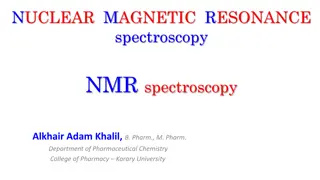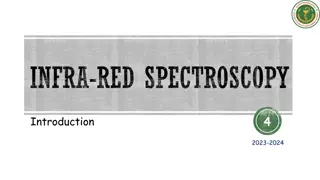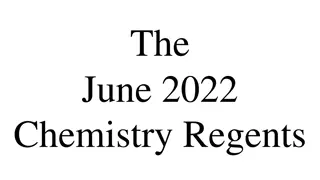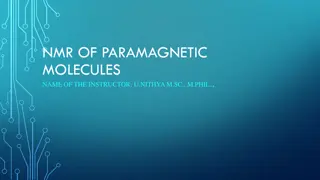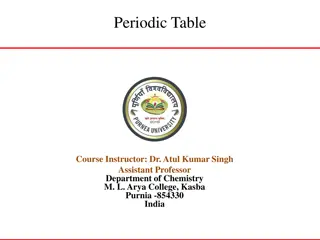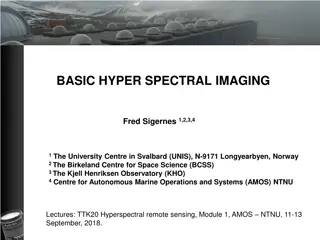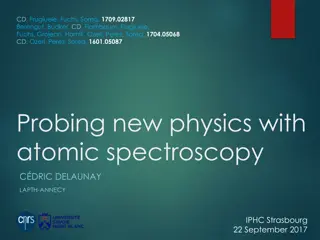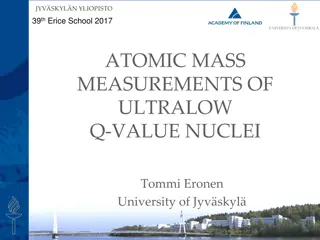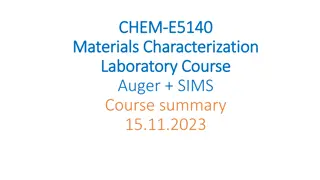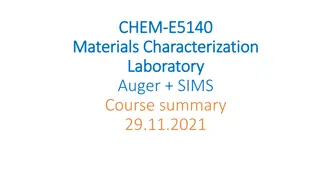Understanding Atomic Spectroscopy and Atomization in Analytical Chemistry
Explore the principles of atomic spectroscopy through examples and theories, focusing on topics such as the Boltzmann distribution problem and atomization processes using flames. Learn about the challenges and complications in atomization, including issues with nebulization efficiency and poor volatilization. Gain insights into matrix effects and secondary processes affecting atomization in analytical chemistry applications.
Download Presentation

Please find below an Image/Link to download the presentation.
The content on the website is provided AS IS for your information and personal use only. It may not be sold, licensed, or shared on other websites without obtaining consent from the author. Download presentation by click this link. If you encounter any issues during the download, it is possible that the publisher has removed the file from their server.
E N D
Presentation Transcript
Announcements Second Homework Set (additional problem slight error in first 2.1.1 key posted; since fixed) Today s Lecture Atomic Spectroscopy (Chapter 20) Theory (Boltzmann Distribution Problem) Atomization Flame Electrothermal ICP Spectrometers AA instruments AE instruments
Atomic Spectroscopy Theory Example problem: Calcium absorbs light at 422 nm. Calculate the ratio of Ca atoms in the excited state to the ground state at 3200 K (temperature in N2O fueled flame). g*/g0= 3 (3 5p orbitals to 1 4s orbital).
Atomic Spectroscopy Atomization air nebulizer Flame Atomization used for liquid samples liquid pulled by action of nebulizer nebulizer produces spray of sample liquid droplets evaporate in spray chamber leaving particles fuel added and ignited in flame atomization of remaining particles and spray droplets occurs in flame optical beam through region of best atomization liquid light beam burner head spray chamber oxidant (air or N2O) fuel (HCCH) nebulizer sample in
Atomic Spectroscopy Atomization Atomization in flames Processes nebulization of liquid: MgCl2(aq) MgCl2(spray droplet) evaporation of solvent: MgCl2(spray droplet) MgCl2(s) Volatilization in flame: MgCl2(s) MgCl2(g) Atomization (in hotter part of flame): MgCl2(g) Mg(g) + Cl2(g) Target species for absorption measurement
Atomic Spectroscopy Atomization Complications/Losses Ideally, every atom entering nebulizer ends up as gaseous atom In practice, at best only a few % of atoms become atoms in flame The nebulization process is not that efficient (much of water hits walls and goes out drain) Poor volatilization also occurs with less volatile salts (e.g. many phosphates)
Atomic Spectroscopy Atomization Complications/Losses (continued) Poor atomization also can occur due to secondary processes such as: Formation of oxides + hydroxides (e.g. 2Mg (g) + O2 (g) 2MgO (g)) Ionization (Na (g) + Cl (g) Na+ (g) + Cl- (g)) If the atomization is affected by other compounds in sample matrix (e.g. the presence of phosphates), this is called a matrix effect (discussed more later)
Atomic Spectroscopy Atomization Electrothermal Atomization Atomization occurs in a graphite furnace Process is different in that a small sample is placed in a graphite tube and atomization occurs rapidly but in a discontinuous manner Electrothermal atomization is more efficient; atoms spend more time in the beam path, and less sample is required resulting in much greater sensitivity Concentration LODs are typically ~100 times lower (e.g. 100 ppt for EA vs. 10 ppb for flame) Mass LODs are even lower (100 pg/mL*0.01 mL = 1 pg for EA vs. 10 ng/mL*2 mL = 20 ng for flame)
Atomic Spectroscopy Atomization Graphite Tube in Chamber (not shown) Electrothermal Atomization (Process) Sample is placed through hole onto L vov platform Graphite tube is heated by resistive heating This occurs in steps (dry, char, atomize, clean) Sample in L vov Platform Ar in chamber flow stops and optical measurements made Clean + cool down T dry char atomize time
Atomic Spectroscopy Atomization Inductively Coupled Plasma (ICP) A plasma is induced by radio frequency currents in surrounding coil Once a spark occurs in Ar gas, some electrons leave Ar producing Ar+ + e- The sample is introduced by nebulization in the Ar stream The accelerations of Ar+ and e- induce further production of ions and great heat production Much higher temperatures are created (6000 K to 10000 K vs. flames) ICP Torch Plasma RF Coil Quartz tube Argon + Sample
Atomic Spectroscopy Atomization Advantages of ICP Atomization Greater atomization efficiency than in flame AA (partly because better nebulizers are used than with flames due to higher total instrument cost and partly due to higher temperatures) Fewer matrix effects because atomization is more complete at higher temperatures High temperature atomization allows much greater emission flux + more ionization allowing coupling with emission spectrophotometers and mass spectrometers Emission and MS allow faster multi-element analysis
Chapter 20 Questions 1. Why would it be difficult to use a broadband light source and monochromator to produce light used in AA spectrometers? List three methods for atomizing elements. List two processes that can decrease atomization efficiency in flame atomization. What is an advantage in using electrothermal atomization in AAS? Which atomization method tends to result in the most complete breakdown of elements to atoms in the gas phase? Why is ICP better for emission measurements than flame? 2. 3. 4. 5. 6.
Atomic Spectroscopy Absorption Spectrometers Flame or graphite tube Lamp source monochromator Light detector The lamp is a hollow cathode lamp containing the element(s) of interest in cathode The lamp is operated under relatively cool conditions at lower pressures to reduce Doppler and pressure broadening of atomic emission lines A very narrow band of light emitted from hollow cathode lamps is needed so that absorption by atoms in flame mostly follows Beer s law The monochromator serves as a coarse filter to remove other wavelength bands from light and light emitted from flames
Atomic Spectroscopy Absorption Spectrometers hollow cathode lamp emission A narrower emission spectrum from hollow cathode lamp (vs. flame absorption) results in better Beer s law behavior Atomic absorption spectrum in flame Intensity or absorbance Additional broadening in flame from temperature (Doppler) or pressure wavelength
Atomic Spectroscopy Interference in Absorption Measurements Spectral Interference Very few atom atom interferences Interference from flame (or graphite tube) emissions are reduced by modulating lamp no lamp: signal from flame vs. with lamp then with lamp: signal from lamp + flame absorption by atoms Interference from molecular species absorbing lamp photons (mostly at shorter wavelengths and light scattering in EA-AA) This interference can be removed by periodically using a deuterium lamp (broad band light source) or using the Zeeman effect (magnetic splitting of absorption bands)
Atomic Spectroscopy Interference in Absorption Measurements Chemical Interference Arises from compounds in sample matrix or atomization conditions that affects element atomization Some examples of specific problems (mentioned previously) and solutions: Poor volatility due to PO43- add Ca because it binds strongly to PO43- allowing analyte metal to volatilize better or use hotter flames Formation of metal oxides and hydroxides use fuel rich flame Ionization of analyte atoms add more readily ionizable metal (e.g Cs) Another approach is to use a standard addition calibration procedure (this won t improve atomization but it accounts for it so that results are reliable)
Atomic Spectroscopy Interference in Absorption Measurements standards in water Standard Addition Used when sample matrix affects response to analytes Commonly needed for AAS with complicated samples Standard is added to sample (usually in multiple increments) Needed if slope is affected by matrix Concentration is determined by extrapolation (= |X- intercept|) Absorbance Sample Analyte Concentration Concentration Added = = + b = m 0 A X mX b /
Atomic Spectroscopy Emission Spectrometers In emission measurements, the plasma (or flame) is the light source Flame sources are generally limited to a few elements (only hot enough for low E visible light emissions) A monochromator or polychromator is the means of wavelength discrimination Sensitive detectors are needed ICP-AES is faster than AAS because switching monochromator settings can be done faster than switching lamp plus flame conditions Plasma (light source + sample) Monochromator or Polychromator Light detector or detector array Liquid sample, nebulizer, Ar source
Atomic Spectroscopy Emission Spectrometers Sequential vs. Simultaneous Instruments Sequential Instruments use: A standard monochromator Select for elements by rotating the monochromator grating to specific wavelengths Simultaneous Instruments use: A 1D or 2D polychromator (Harris Color Plate 24/25) 1D instruments typically use photomultiplier detectors behind multiple exit slits 2D instrument shown in 4/1 lecture slide 13 Selected elements (1D instruments) or all elements can be analyzed simultaneously resulting in faster analysis and less sample consumption.
Atomic Spectroscopy Interference in Emission Measurements Interferences Atom atom interferences more common than in atomic absorption because monochromators offer less selectivity than hollow cathode lamps Interference from molecular emissions are reduced by scanning to the sides of the atomic peaks Chemical interferences are less prevalent due to greater atomization efficiency Emission Spectrum Atomic peak background


